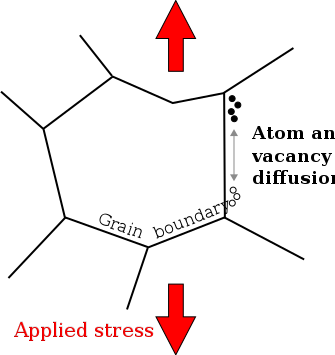
Coble creep, a form of diffusion creep, is a mechanism for deformation of crystalline solids. Contrasted with other diffusional creep mechanisms, Coble creep is similar to Nabarro–Herring creep in that it is dominant at lower stress levels and higher temperatures than creep mechanisms utilizing dislocation glide.[1] Coble creep occurs through the diffusion of atoms in a material along grain boundaries. This mechanism is observed in polycrystals or along the surface in a single crystal, which produces a net flow of material and a sliding of the grain boundaries.
Robert L. Coble first reported his theory of how materials creep across grain boundaries and at high temperatures in alumina. Here he famously noticed a different creep mechanism that was more dependent on the size of the grain.[2]
The strain rate in a material experiencing Coble creep is given by
where
- is a geometric prefactor
- is the applied stress,
- is the average grain diameter,
- is the grain boundary width,
- is the diffusion coefficient in the grain boundary,
- is the vacancy formation energy,
- is the activation energy for diffusion along the grain boundary
- is the Boltzmann constant,
- is the temperature in kelvins
- is the atomic volume for the material.
- ^ Courtney, Thomas (2000). Mechanical behavior of Materials. p. 293-353.
- ^ Coble, Robert L. (15 October 1962). "A Model for Boundary Diffusion Controlled Creep in Polycrystalline Materials". Journal of Applied Physics. doi:10.1063/1.1702656.










